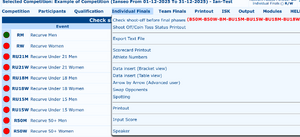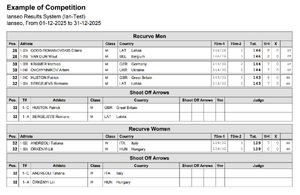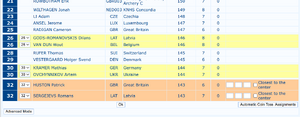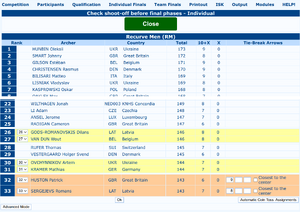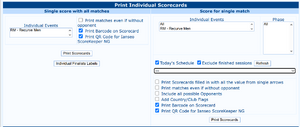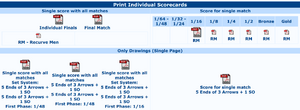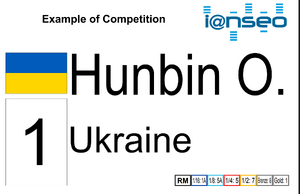Individual Finals: Difference between revisions
No edit summary |
No edit summary |
||
| (14 intermediate revisions by 3 users not shown) | |||
| Line 1: | Line 1: | ||
{{Page in progress}} |
|||
The Individual and Team Finals, or Elimination and Final Rounds, are one of the most important |
|||
stages in a tournament. Though they can seem hard to be managed at first, once the user will learn the basic |
|||
management method, organizing national competitions will be much easier and flawless. |
|||
<languages/> |
|||
== Setting the Elimination Round == |
|||
The Individual and Team Finals, also called Elimination (up to 1/8) and Final (from 1/4 to medals) Rounds, are usually the most important |
|||
Before starting the Elimination Round, the user has to check for any tied scores, mainly, in the last place |
|||
stages in a tournament. Though they can seem hard to be managed at first, once the user gets used to the basic |
|||
granting access to the Finals. When there are tied archers, the user can check their ranking through the windows |
|||
management method, competitions will be much easier to manage and flawless. |
|||
that can be opened clicking on: |
|||
== Set up == |
|||
'''Individual Finals → Check shoot-off before final rounds''' |
|||
Settings are defined in [[Competition/Individual Events Setup]] |
|||
== Check and resolve tie scores == |
|||
All the tournament Divisions and Classes highlighted in red concern tied archers (as in the first row of both |
|||
<div style="overflow: hidden">[[File:Individual-Finals-menu-01.png|thumb|Individual Finals Menu - no ties solved]] |
|||
[[File:Individual-Finals-menu-02.png|thumb|Individual Finals Menu - some ties solved]] |
|||
management, it simply points out the shoot-offs to be broken before starting Final Rounds. |
|||
Before starting the matches, ties need to be solved in order to send athletes from ranking round to the correct places in the brackets. Ties can be solved through ''Shoot Offs'' (SO) or ''Coin Tosses'' (CT), depending on the rules of the competition. Usually SO are needed for the last positions in the "saved" places (the ones granting direct access to a different phase than the first one) or the last positions of the bracket places. Ties in other positions are usually solved with Coin Tosses. |
|||
{{Note|type=error|text=Once ties are resolved, redoing the procedure will void the matches already done!}} |
|||
<placeholder: Figure 4.1: The menu highlighting shoot-offs to be broken before starting Final Rounds> |
|||
The procedure starts selecting <code>Individual Finals => Check shoot-off before final phases</code>, the submenu differ if no events have been checked or at least one has been solved. The red highlighted events in the menu item show which events have not been checked yet. |
|||
To break shoot-offs and proceed to Elimination and Final Rounds, the user has to click ''OK'' on each screen, |
|||
</div> |
|||
after choosing ''All'' (or the wished Division) in the drop-down menu (meaning that the user has to confirm each |
|||
selected Division and Class), so that the program will save that there are no shoot-offs to break. In case of |
|||
shoot-offs, matches will be highlighted, and, once ties are shot, the user can simply input the scores of the |
|||
shooting athletes to break them (on the right) and modify the relative position in final rankings (on the left). |
|||
<div style="overflow: hidden">[[File:Individual-Finals-Ties-01.png|thumb|List of Events to check/checked]] |
|||
<placeholder: Figure 4.2: Shoot-offs to be broken, with tie scores and Final Ranking position.> |
|||
[[File:Individual-Finals-Ties-04.png|thumb|Events list after tie score check]] |
|||
The list of events to check is presented, on the left the dot shows the status of each event: a green dot means all done, a red dot means the check needs to be performed. |
|||
Once scores are entered, the user can click on ‘''OK''’ and break the tie (see Figure 4.2). To view the last updates |
|||
in the rankings and check for shot-offs, the user can click on the second item in the menu, '''Shoot Off/Coin |
|||
Toss Status Printout''', which will print a document with the names of tied archers (see Figure 3.11). |
|||
Checks need to be performed one event at a time. |
|||
==Setting the Field Layout== |
|||
Before explaining how to manage matches and the related printouts, the user has to set up a quick, but |
|||
important, section, related to the Field Layout for Finals, which could rise planning issues, as organizing |
|||
committees perfectly know. To manage the Field Layout setup, the user should open the page: |
|||
</div> |
|||
'''''Competition'' → ''Individual Finals Setup''.''' |
|||
<div style="overflow: hidden">[[File:Individual-Finals-Ties-PDF.png|thumb|Tie score and SO scorecard PDF]] |
|||
In this section, the user can set a list of parameters that enable organizing committees to manage all the tasks |
|||
For each Event, a recap of the number of SO and CT to be done is shown. A PDF with the scorecards for the SO can be printed to hand to the judges. Instead of a single status per Event, a global status can be printed from the <code>Individual Finals => Shoot Off/Coin Toss Status Printout</code> menu item |
|||
related to Individual and Team Finals (see Figure 4.3). |
|||
</div> |
|||
< |
<div style="overflow: hidden">[[File:Individual-Finals-Ties-02.png|thumb|CT and SO panel]] |
||
[[File:Individual-Finals-Ties-03.png|thumb|Tie score panel after CT and SO]] |
|||
Clicking on an Event, the ranking round results of the qualified archers is shown, with selects in case of CT (yellow rows) and selects+input fields to insert the points of the SO. |
|||
An <code class="button">Automatic Coin Toss Assignments</code> button at the bottom right of the page helps speeding the CT by assigning randomly a position to the CT. SO need to be assigned manually based on the rules. |
|||
===Manage Events=== |
|||
{{note|type=info|text=World Archery rules state that the SO points only serve to exclude or include archers from the brackets, the actual ranking inside/outside the brackets is done as usual based on regular tie breakers and CT}} |
|||
This option shows the list of all the Individual Events that can be edited row by row. |
|||
Obviously, the most important item is the Initial stage. Using the drop-down menu, the user can |
|||
customize the first event (Session) in the Elimination and Final Rounds (see Figure 4.4). |
|||
An <code class="button">Advanced Mode</code> button on the bottom left of the page comes in handy if specific situations arise: you will be able to manually change all the positions to use in assigning archers to the bracket. |
|||
<placeholder: Figure 4.4: Managing Individual Events> |
|||
This is also the button to press to access the <code class="button">Reset Data to situation before SO</code> button. |
|||
===Archers on Targets=== |
|||
Clicking on this item, the software will open an empty page, where the user can |
|||
choose the wished event. Clicking, then, on ‘''OK''’, the software will enable the user to manage the |
|||
number of athletes per target (see Figure 4.5). By clicking on '''Field of Play Layout''', the user can |
|||
print the ''Layout of the Final Matches Field''. This view is really useful for organizing committees, |
|||
since it enables the user to intuitively arrange targets for the final rounds in a fast way. |
|||
{{note|type=error|text=Once the ties are solved, tampering with these items will bring up warning popups. Read carefully as unwanted actions will not be able to be undone!}} |
|||
<placeholder: Figure 4.5: Managing Targets (after choosing Division and Class).> |
|||
</div> |
|||
===Arrows per Set=== |
|||
Generally, this screen is used only as informative reference, since the number of arrows |
|||
and ends doesn’t change from tournament to tournament, but it’s always defined by the existing rules |
|||
(see Figure 4.6). |
|||
==Export Text File== |
|||
<placeholder: Figure 4.6: Managing the number of Arrows per Set (after choosing Division and Class).> |
|||
All the matches will be exported as semicolon separated values (.csv) |
|||
===Targets Number=== |
|||
It enables the user to manage the Targets Number (in Grid View mode) for each |
|||
event. Starting from the first step, the user can input the Targets Number to arrange the Finals Field |
|||
Layout for each set of matches (see Figure 4.7). |
|||
==Scorecard Printout== |
|||
<placeholder: Figure 4.7: Inputting the Targets Number (after choosing Division and Class).> |
|||
=== |
===Top of page=== |
||
<div class="nofloat"> |
|||
From this section, the user can create the tournament agenda (''Scheduling'') for the Elimination |
|||
[[File:Individual-Finals-Scorecards-01.png|thumb|Individual Finals Scorecards, top of page]] |
|||
and Finals Rounds. It is a major step, but it is not vital for the tournament management (see Par. 5.5). |
|||
This section allows to print scorecards all matches of an archer on a single page, all matches of a single event or all matches of a single phase. |
|||
Checkboxes activate some items: very useful are the Barcodes printed on scorecards because it greatly speeds up the score control and validation after the matches. |
|||
===Warm Up Schedule=== |
|||
In this section the user can manage, if needed, the number of targets on which archers |
|||
can shoot the scheduled Warm Up Ends (see Par. 5.5). |
|||
To print the scorecards of a specific phase (provided a schedule has been created), select the phase from the dropdown item on the middle of the right size of the section |
|||
===Manage Running Events=== |
|||
</div> |
|||
This section is meant for managing ''Running Events''. |
|||
===Middle of page=== |
|||
The description sequence is based on the events order, or, following the explanation of each command, the |
|||
<div class="nofloat"> |
|||
user can create a schedule for a tournament in a simple, complete and fast way. |
|||
[[File:Individual-Finals-Scorecards-02.png|thumb|Individual Finals Scorecards, middle of page]] |
|||
Similar to the previous section, showing which scorecards can be printed (big icon) and which are not ready yet. |
|||
</div> |
|||
===Nameplates=== |
|||
==Inputting results== |
|||
<div class="nofloat"> |
|||
[[File:Individual-Finals-Scorecards-03.png|thumb|Individual Finals Scorecards, Nameplates]] |
|||
[[File:Individual-Finals-Nameplates.png|thumb|Individual Nameplates]] |
|||
Prints the nameplates to be put on the shooting line or at the targets. The targets of the following phases after winning the match can also be printed. |
|||
</div> |
|||
==Athlete Numbers== |
|||
Inputting results of Elimination and Final Rounds is a simple task. In the ''Individual Finals/Team Finals'' |
|||
Similarly to the Qualification Rounds, Athlete Numbers specific for the Final rounds can be printed ([[Qualification#Athlete_Numbers|see Qualification => Athlete_Numbers]]). |
|||
menu (see Figure 4.8) the software offers the following options. |
|||
==Data Insert == |
|||
<placeholder: Figure 4.8: Individual Finals menu> |
|||
There are many ways to insert results data in the system. |
|||
===Data insert (Bracket view)=== |
|||
===Scorecard Printout=== |
|||
{{memo|insert picture}} |
|||
As per its title, this command enables the user to print Scorecards for the Final |
|||
This is the fastest way of data input for Matches: selecting the event to manage and if ties need to be managed a bracket will appear. Just enable the phase to manage and insert the final score of each match. Results are immediately saved and the archers transferred to the following phases. |
|||
Rounds (see Figure 4.9). The software upholds two types of scorecards: '''Single score with all |
|||
matches''' (on the ''left'') and S'''core for single match''' (on the ''right''). These two types of scorecards |
|||
only differ for their convenience. The right templates combine all Elimination and Final Rounds for a |
|||
single athlete on a ''single sheet'', as the archer will have to keep the scorecard up to the last match shot, |
|||
the other templates are divided per ''match'', as shown by columns divisions. |
|||
From the ''graphic'' point of view, it is recommended to print a blank scorecard each time, without |
|||
previous scores from shot Elimination and Final Rounds. It is, then, suggested to avoid using these |
|||
scorecards, except for tournaments in which electronic scoring devices are in use, or when enough |
|||
volunteers are available to collect and rearrange scorecards, for the data inputting before proceeding in |
|||
the tournament might be significantly time consuming. |
|||
As for the previous printouts pages, the software offers all the needed files, divided by Matches in the |
|||
''first row'', Division and Class, in the ''second row'', and for the user selection in the scroll-down window |
|||
''in the lowest part''. The user can also print Labels for each single athlete for the Final Rounds, just |
|||
as for Qualification Rounds. Similarly, in the single scorecard area, the user can print scorecards with |
|||
all the values from single arrows (available for tournaments in which electronic scoring devices are in |
|||
use). Scrolling down the page, the software offers other printouts, including blank scorecards without |
|||
names and, eventually, the chance of printing participants to Elimination and Final Rounds, by choosing |
|||
to print all the archers, or just the wished athletes. |
|||
* In case of a bye or a disqualification, the appropriate item needs to be selected from the dropdown menu after selecting "Manage Tie-Break" from the top selector |
|||
<placeholder: Figure 4.9: Finals Scorecards Printout page.> |
|||
* In case of SO, after inserting the SO result one should select "Tie Winner" from the dropown |
|||
===Athlete Numbers=== |
|||
Similarly to the Qualification Rounds, the user can print Athlete Numbers for the Final |
|||
Rounds (see Figure 4.10). |
|||
===Data insert (Table view)=== |
|||
<placeholder: Figure 4.10: Athlete Numbers Printout for the Final Rounds.> |
|||
{{memo|insert picture}} |
|||
In table view scores can be entered by schedule or selecting a specific phase from multiple events. |
|||
Single end scores can also be entered. |
|||
===Data insert (Bracket view)=== |
|||
This is the most efficient way of inputting data for Elimination Rounds. |
|||
Clicking on this command, the software will open a drop-down menu, from which the user can manage |
|||
the wished event. After choosing and confirming the selected option, the application will display a |
|||
bracket template, with the same framework of Elimination and Final Rounds, but with names and boxes |
|||
for inputting scores (see Figure 4.11). |
|||
Once all scores are entered, pressing save will actually save the results. Top of table show some useful quick links: |
|||
<placeholder: Figure 4.11: Data insert in Bracket view.> |
|||
* '''previous phase''' go back one phase for the same event |
|||
* '''next phase''' go to next phase of the same event |
|||
* '''brackets''' switch to the <code>Data insert (Bracket view)</code> |
|||
* '''Next phase Scorecards''' prints next phase scorecards of this event |
|||
* '''Next phase Names''' prints the next phase platenames |
|||
===Arrow by Arrow (Advanced users)=== |
|||
===N.B.=== |
|||
{{memo|insert picture}} |
|||
Before choosing any event, the user should select any shot-offs that need breaking from the dropdown menu on the right (''Manage Tie-Break''), to input any scores from the corresponding shoot-offs. |
|||
===Swap opponents=== |
|||
For inputting scores, both in the ''Set Systems'' and in the ''Cumulative Systems'', the user has to click |
|||
{{memo|insert picture}} |
|||
[Enable] on the wished column, to edit the scores fields. In case of Byes, the user has to choose the |
|||
option ‘Bye’ in the drop-down menu beside the winner’s name. By default, the program will make the |
|||
athlete advance to the following rounds. Should an athlete have no opponents, i@nseo will move the |
|||
archer directly to the next round. |
|||
In case of tied matches, the user has to input the score of each shoot-off arrow in the last empty box on |
|||
the left of each row and, then, select ‘Tie Winner’ in the drop-down menu beside the winner’s name. |
|||
In case of tied scores, usually, a star is added after the score of the shoot-off arrow of the winner athlete |
|||
(for it is the closest to the face center; see Figure 4.12). |
|||
<placeholder: Figure 4.12: Inputting Byes and Shoot-offs scores.> |
|||
===Data insert (Table view)=== |
|||
Another way of inputting scores during Elimination and Final Rounds is using |
|||
the Table view. In this case, the page won’t display brackets, but a chart, from which the user can input |
|||
both ''scores of single ends'', and ''set/cumulative scores''. For a standard tournament, when |
|||
electronic devices are not in use, the effectiveness of this scoring method is significantly lessened. Plus, |
|||
in the first top row, the software offers a list of commands to browse the wished round of matches, as |
|||
the user can move to the ''Previous Phase'' or to the ''Next Phase'', view the ''Brackets'' up until then, |
|||
and print the ''Next Phase Scorecards'' (even for a single match, obviously), or the ''Next Phase |
|||
Names'' to prepare athletes name stands (see Figure 4.13). |
|||
<placeholder: Figure 4.13: Data insert in Table view.> |
|||
===Spotting=== |
===Spotting=== |
||
{{memo|insert picture}} |
|||
This function is used for the '''Arrow by Arrow''' inputting. It enables the user to input the match |
|||
results live, and, consequently, on sight. This method is meant for national tournaments and |
|||
international competitions (see Par. 5.9). |
|||
===Printout=== |
|||
See Par. 4.4. |
|||
===Speaker=== |
|||
This page enables the announcer to read the general overview of all the running Elimination |
|||
and Final Rounds, both ended or not, to promptly announce the results to onsite spectators. It is |
|||
meant for international competitions and national tournaments (see Par. 5.10). |
|||
Likewise, the user can also manage Team Matches. The procedure is similar, as it starts by setting the |
|||
tournament field in the same way of the Individual Finals, opening the command |
|||
'''''Competition'' → T''eam Finals Setup''''' |
|||
and printing ''Brackets'', ''Scorecards'' and ''Results'', using the menu for '''Team Finals'''. All the tasks follow |
|||
the same procedure that has been previously described for the Individual Finals management. |
|||
==Final Rounds Printout== |
|||
This menu integrates all Printout commands and templates available in the software. Opening the main page |
|||
and clicking on ''Printout'', the following commands will be displayed (see Figure 4.14): |
|||
<placeholder: Figure 4.14: Printout menu.> |
|||
===Participant Lists=== |
|||
It enables the user to print all the Participants in the tournament (see Figure 2.40 and |
|||
Figure 2.41 in Par. 2.4). |
|||
===Statistics=== |
|||
This command prints all the Statistics about the competition (see Figure 2.37 in Par. 2.4). |
|||
===Div/Class Result List=== |
|||
From this function, the user can print rankings for Qualification Rounds (see Figure |
|||
3.11 in Par. 3.1). |
|||
===Qualification Round Printout=== |
|||
From this command, the user can print Final Rankings for the |
|||
tournament to be used in the Elimination and Final Rounds (see Figure 3.12 in Par. 3.1). |
|||
===Final Rounds=== |
|||
This function prints rankings for the Final Rounds, using both Brackets and Final Rankings |
|||
templates (see Figure 4.15). |
|||
<placeholder: Figure 4.15: Rankings Printout for Final Rounds.> |
|||
===Header for Result Printouts=== |
|||
It enables the user to input a row, based on the tournament management |
|||
(e.g. ''non-official results''), on rankings to be printed, simply selecting the Session and entering the |
|||
wished text in the empty box (see Figure 4.16). |
|||
<placeholder: Figure 4.16: Header for Result Printouts page.> |
|||
==Printout== |
|||
===Awards Ceremony Management=== |
|||
From this section, the user can manage the Awards Ceremony for |
|||
archers in the tournament, choosing the ''Number of Awarded Athletes'' for each event, the ''Name |
|||
of the Cup'' and the ''Awarder''. It is mainly meant for Awards Ceremonies of international competitions |
|||
and national tournaments (see Figure 4.17). |
|||
==Input Score== |
|||
<placeholder: Figure 4.17: Awards Ceremony Management page.> |
|||
==Speaker== |
|||
===Awards Printout=== |
|||
This command prints the Awards Ceremony schedule including Athletes, Awards and |
|||
Awarders entered in the previous section. |
|||
===Print Sign=== |
|||
From this section, the user can print any Sign (e.g. any direction) needed for correctly directing |
|||
athletes on the tournament field. Usually, the first row includes any instructions, and the second one |
|||
should add any directions. Symbols usually typed in the rows are ‘>’ for the ''Right Turn Indication'', |
|||
‘<’ for the ''Left Turn Indication'' and ∧∧ for the ''‘Go Straight’ Indication''. These symbols should |
|||
be entered without adding any other character. Otherwise, the program will add that alphanumeric |
|||
character in the print (see Figure 4.18). |
|||
{{Content}} |
|||
<placeholder: Figure 4.18: Printed Sign sample.> |
|||
Latest revision as of 10:50, 13 October 2025
This page is in progress Please check back later for additional changes. |
The Individual and Team Finals, also called Elimination (up to 1/8) and Final (from 1/4 to medals) Rounds, are usually the most important stages in a tournament. Though they can seem hard to be managed at first, once the user gets used to the basic management method, competitions will be much easier to manage and flawless.
Set up
Settings are defined in Competition/Individual Events Setup
Check and resolve tie scores
Export Text File
All the matches will be exported as semicolon separated values (.csv)
Scorecard Printout
Top of page
This section allows to print scorecards all matches of an archer on a single page, all matches of a single event or all matches of a single phase.
Checkboxes activate some items: very useful are the Barcodes printed on scorecards because it greatly speeds up the score control and validation after the matches.
To print the scorecards of a specific phase (provided a schedule has been created), select the phase from the dropdown item on the middle of the right size of the section
Middle of page
Similar to the previous section, showing which scorecards can be printed (big icon) and which are not ready yet.
Nameplates
Prints the nameplates to be put on the shooting line or at the targets. The targets of the following phases after winning the match can also be printed.
Athlete Numbers
Similarly to the Qualification Rounds, Athlete Numbers specific for the Final rounds can be printed (see Qualification => Athlete_Numbers).
Data Insert
There are many ways to insert results data in the system.
Data insert (Bracket view)
[NB: insert picture!] This is the fastest way of data input for Matches: selecting the event to manage and if ties need to be managed a bracket will appear. Just enable the phase to manage and insert the final score of each match. Results are immediately saved and the archers transferred to the following phases.
- In case of a bye or a disqualification, the appropriate item needs to be selected from the dropdown menu after selecting "Manage Tie-Break" from the top selector
- In case of SO, after inserting the SO result one should select "Tie Winner" from the dropown
Data insert (Table view)
[NB: insert picture!] In table view scores can be entered by schedule or selecting a specific phase from multiple events.
Single end scores can also be entered.
Once all scores are entered, pressing save will actually save the results. Top of table show some useful quick links:
- previous phase go back one phase for the same event
- next phase go to next phase of the same event
- brackets switch to the
Data insert (Bracket view) - Next phase Scorecards prints next phase scorecards of this event
- Next phase Names prints the next phase platenames
Arrow by Arrow (Advanced users)
[NB: insert picture!]
Swap opponents
[NB: insert picture!]
Spotting
[NB: insert picture!]


